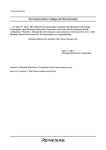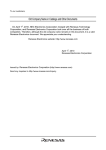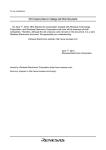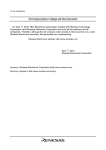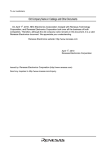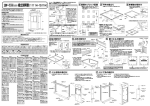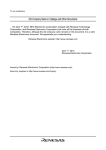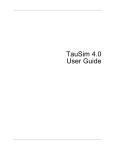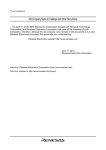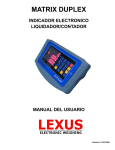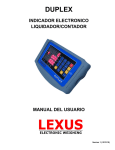Download EMMA Mobile1 Application Note SPI Interface
Transcript
To our customers, Old Company Name in Catalogs and Other Documents On April 1st, 2010, NEC Electronics Corporation merged with Renesas Technology Corporation, and Renesas Electronics Corporation took over all the business of both companies. Therefore, although the old company name remains in this document, it is a valid Renesas Electronics document. We appreciate your understanding. Renesas Electronics website: http://www.renesas.com April 1st, 2010 Renesas Electronics Corporation Issued by: Renesas Electronics Corporation (http://www.renesas.com) Send any inquiries to http://www.renesas.com/inquiry. Notice 1. 2. 3. 4. 5. 6. 7. All information included in this document is current as of the date this document is issued. Such information, however, is subject to change without any prior notice. Before purchasing or using any Renesas Electronics products listed herein, please confirm the latest product information with a Renesas Electronics sales office. Also, please pay regular and careful attention to additional and different information to be disclosed by Renesas Electronics such as that disclosed through our website. Renesas Electronics does not assume any liability for infringement of patents, copyrights, or other intellectual property rights of third parties by or arising from the use of Renesas Electronics products or technical information described in this document. No license, express, implied or otherwise, is granted hereby under any patents, copyrights or other intellectual property rights of Renesas Electronics or others. You should not alter, modify, copy, or otherwise misappropriate any Renesas Electronics product, whether in whole or in part. Descriptions of circuits, software and other related information in this document are provided only to illustrate the operation of semiconductor products and application examples. You are fully responsible for the incorporation of these circuits, software, and information in the design of your equipment. Renesas Electronics assumes no responsibility for any losses incurred by you or third parties arising from the use of these circuits, software, or information. When exporting the products or technology described in this document, you should comply with the applicable export control laws and regulations and follow the procedures required by such laws and regulations. You should not use Renesas Electronics products or the technology described in this document for any purpose relating to military applications or use by the military, including but not limited to the development of weapons of mass destruction. Renesas Electronics products and technology may not be used for or incorporated into any products or systems whose manufacture, use, or sale is prohibited under any applicable domestic or foreign laws or regulations. Renesas Electronics has used reasonable care in preparing the information included in this document, but Renesas Electronics does not warrant that such information is error free. Renesas Electronics assumes no liability whatsoever for any damages incurred by you resulting from errors in or omissions from the information included herein. Renesas Electronics products are classified according to the following three quality grades: “Standard”, “High Quality”, and “Specific”. The recommended applications for each Renesas Electronics product depends on the product’s quality grade, as indicated below. You must check the quality grade of each Renesas Electronics product before using it in a particular application. You may not use any Renesas Electronics product for any application categorized as “Specific” without the prior written consent of Renesas Electronics. Further, you may not use any Renesas Electronics product for any application for which it is not intended without the prior written consent of Renesas Electronics. Renesas Electronics shall not be in any way liable for any damages or losses incurred by you or third parties arising from the use of any Renesas Electronics product for an application categorized as “Specific” or for which the product is not intended where you have failed to obtain the prior written consent of Renesas Electronics. The quality grade of each Renesas Electronics product is “Standard” unless otherwise expressly specified in a Renesas Electronics data sheets or data books, etc. “Standard”: 8. 9. 10. 11. 12. Computers; office equipment; communications equipment; test and measurement equipment; audio and visual equipment; home electronic appliances; machine tools; personal electronic equipment; and industrial robots. “High Quality”: Transportation equipment (automobiles, trains, ships, etc.); traffic control systems; anti-disaster systems; anticrime systems; safety equipment; and medical equipment not specifically designed for life support. “Specific”: Aircraft; aerospace equipment; submersible repeaters; nuclear reactor control systems; medical equipment or systems for life support (e.g. artificial life support devices or systems), surgical implantations, or healthcare intervention (e.g. excision, etc.), and any other applications or purposes that pose a direct threat to human life. You should use the Renesas Electronics products described in this document within the range specified by Renesas Electronics, especially with respect to the maximum rating, operating supply voltage range, movement power voltage range, heat radiation characteristics, installation and other product characteristics. Renesas Electronics shall have no liability for malfunctions or damages arising out of the use of Renesas Electronics products beyond such specified ranges. Although Renesas Electronics endeavors to improve the quality and reliability of its products, semiconductor products have specific characteristics such as the occurrence of failure at a certain rate and malfunctions under certain use conditions. Further, Renesas Electronics products are not subject to radiation resistance design. Please be sure to implement safety measures to guard them against the possibility of physical injury, and injury or damage caused by fire in the event of the failure of a Renesas Electronics product, such as safety design for hardware and software including but not limited to redundancy, fire control and malfunction prevention, appropriate treatment for aging degradation or any other appropriate measures. Because the evaluation of microcomputer software alone is very difficult, please evaluate the safety of the final products or system manufactured by you. Please contact a Renesas Electronics sales office for details as to environmental matters such as the environmental compatibility of each Renesas Electronics product. Please use Renesas Electronics products in compliance with all applicable laws and regulations that regulate the inclusion or use of controlled substances, including without limitation, the EU RoHS Directive. Renesas Electronics assumes no liability for damages or losses occurring as a result of your noncompliance with applicable laws and regulations. This document may not be reproduced or duplicated, in any form, in whole or in part, without prior written consent of Renesas Electronics. Please contact a Renesas Electronics sales office if you have any questions regarding the information contained in this document or Renesas Electronics products, or if you have any other inquiries. (Note 1) “Renesas Electronics” as used in this document means Renesas Electronics Corporation and also includes its majorityowned subsidiaries. (Note 2) “Renesas Electronics product(s)” means any product developed or manufactured by or for Renesas Electronics. Application Note Multimedia Processor for Mobile Applications SPI Interface -------------------------------------------------------------------------------------- EMMA Mobile1 Document No. Date Published S19901EJ1V0AN00 Aug. 2009 2009 Printed in Japan PREFACE PREFACE Purpose The purpose of this document is to specify the usage of EMMA Mobile1 SPI interface. Organization This document includes the following: Introduction Usage of SPI Interface Example of SPI Operation SPI Driver Function Notation Related document Here explains the meaning of following words in text: Note Explanation of item indicated in the text Caution Information to which user should afford special attention Remark Supplementary information The following tables list related documents. Reference Document Document Name Version Author Description EMMA Mobile 1 SMU&GPIO User’s S19265EJ1V0UM00_ASMUGIO.pdf 1st Edition NECEL S19268EJ1V0UM00_1chip.pdf 1st Edition NECEL S19261EJ1V0UM00_SPI.pdf 1st Edition NECEL EMMA Mobile 1 SPI User’s manual S19255EJ1V0UM00_DMA.PDF 1st Edition NECEL EMMA Mobile 1 DMA User’s manual manual EMMA Mobile 1 one Chip User’s manual Application Note S19901EJ1V0AN00 PREFACE Disclaimers The information contained in this document is subject to change without prior notice in the future. Refer to the latest applicable data sheet(s) and user manual when designing a product for mass production. No part of this document may be copied or reproduced in any form or by any means without the prior written consent of NEC Electronics. NEC Electronics assumes no responsibility for any errors that may appear in this document. NEC Electronics does not assume any liability for infringement of patents, copyrights or other intellectual property rights of third parties by or arising from the use of NEC Electronics products listed in this documents or any other liability arising from the use of such products. No license, express, implied or otherwise, is granted under any patents, copyrights or other intellectual property rights of NEC Electronics or others. Descriptions of circuits, software and other related information in this document are provided for illustrative purposes in semiconductor product operation and application examples. The incorporation of these circuits, software and information in the design of a customers’ equipment shall be done under the full responsibility of the customer. NEC Electronics assume no responsibility for any losses incurred by customers or third parties arising from the use of these circuits, software and information. While NEC Electronics endeavors to enhance the quality, reliability and safety of NEC Electronics products, customers agree and acknowledge that possibility of defects thereof cannot be eliminated entirely. To minimize risks of damage to property or injury (including death) to persons arising from defects in NEC Electronics products, customers must incorporate sufficient safety measures in their design, such as redundancy, firecontainment and anti-failure features. Note) 1. “NEC Electronics” as used in this document means NEC Electronics Corporation and also includes its majority-owned subsidiaries. 2. “NEC Electronics products” means any product developed or manufactured by or for NEC Electronics (as defined above) 3. All trademarks or registered trademarks are the property of their respective owners. Registered trademarks ® and trademarks™ are not noted in this document. Application Note S19901EJ1V0AN00 INDEX 4/41 CONTENTS Chapter 1 Introduction ................................................................................................................. 7 1.1 Outline .................................................................................................................................... 7 1.2 Development Environment..................................................................................................... 7 Chapter 2 Usage of SPI Interface ................................................................................................ 8 2.1 Outline of SPI Data Transfer .................................................................................................. 8 2.2 Detail of Normal SPI Data Transfer Procedure ...................................................................... 9 2.2.1 SPI Initialize..................................................................................................................... 9 2.2.2 Soft Reset ........................................................................................................................ 9 2.2.3 SPI Start......................................................................................................................... 10 2.2.4 Data transfer ...................................................................................................................11 2.2.5 SPI Interrupt Sources .....................................................................................................11 Chapter 3 Example of SPI Operation ......................................................................................... 13 3.1 SPI CPU Example................................................................................................................ 13 3.1.1 Outline of SPI CPU Example......................................................................................... 13 3.1.2 Flow of Data Transfer Procedure................................................................................... 14 3.1.3 Detail of RTC Reading Example Procedure.................................................................. 15 3.1.4 Detail of RTC Setting Example Procedure .................................................................... 17 3.2 SPI DMA Example................................................................................................................ 19 3.2.1 Outline of SPI DMA Example ........................................................................................ 19 3.2.2 Flow of Data Transfer Procedure................................................................................... 20 3.2.3 Detail of Data Transfer Procedure ................................................................................. 21 APPENDIX A SPI Driver Function............................................................................................... 24 A.1 Function List......................................................................................................................... 24 A.2 Global Variable Define ......................................................................................................... 24 A.3 Structure Define ................................................................................................................... 25 A.3.1 SPI_SETUP_ST............................................................................................................ 25 A.4 Function Details ................................................................................................................... 26 A.4.1 Set SPI SCLK Function................................................................................................. 26 A.4.2 SPI Setup Function ....................................................................................................... 27 A.4.3 SPI Start ........................................................................................................................ 29 A.4.4 SPI Soft Reset............................................................................................................... 30 A.4.5 SPI End ......................................................................................................................... 31 A.4.6 Get SPI Status Function................................................................................................ 32 A.4.7 SPI0 Interrupt Handle.................................................................................................... 33 A.4.8 SPI1 Interrupt Handle.................................................................................................... 34 A.4.9 SPI2 Interrupt Handle.................................................................................................... 35 A.4.10 SPI Interrupt Setup...................................................................................................... 36 A.4.11 SPI Interrupt Clear....................................................................................................... 37 Application Note S19901EJ1V0AN00 INDEX 5/41 A.4.12 SPI Send ..................................................................................................................... 38 A.4.13 SPI RW........................................................................................................................ 39 A.4.14 SPI Receive ................................................................................................................ 40 ANNEX Modification History....................................................................................................... 41 Application Note S19901EJ1V0AN00 INDEX 6/41 LIST OF TABLES Table 1-1 Hardware Environment ....................................................................................... 7 Table 1-2 Software Environment......................................................................................... 7 Table A-1 SPI Driver Function List.................................................................................... 24 Table A-2 Global Variable Define...................................................................................... 24 Table A-3 Structure Define................................................................................................ 25 Table A-4 Structure of SPI_SETUP_ST............................................................................ 25 LIST OF FIGURES Figure 2-1 Normal SPI Data Transfer Flow......................................................................... 8 Figure 3-1 Circuit of the SPI CPU Master Mode Data Transfer Example......................... 13 Figure 3-2 Procedure of SPI CPU Master Mode Test....................................................... 14 Figure 3-3 SPI R/W Mode Timing ..................................................................................... 16 Figure 3-4 SPI Write Mode Timing.................................................................................... 18 Figure 3-5 Structure of SPI DMA Mode Data Transfer Example ...................................... 19 Figure 3-6 Procedure of SPI-DMA Data Transfer Operation ............................................ 20 Figure A-1 Stop Display .................................................................................................... 26 Figure A-2 Stop Display .................................................................................................... 27 Figure A-3 SPI End ........................................................................................................... 31 Figure A-4 SPI Send Data Flow ........................................................................................ 38 Figure A-5 SPI R/W Mode Flow ........................................................................................ 39 Figure A-6 SPI Receive Data Flow ................................................................................... 40 Application Note S19901EJ1V0AN00 Chapter 1 Introduction 7/41 Chapter 1 Introduction 1.1 Outline This document will show users how to use the SPI interface of EMMA Mobile1. 1.2 Development Environment Hardware environment of this project is listed as below. Table 1-1 Hardware Environment Name Version Maker EMMA Mobile 1 evaluation board (PSKCH2YS-0016-01) - NEC Electronics M20 Kyoto Microcomputer Co. Ltd PARTNER-Jet ICE ARM Software used in this project is listed as below. Table 1-2 Software Environment Version Maker GNUARM Toolchain Name V4.3.2 GNU WJETSET-ARM V5.10a Kyoto Microcomputer Co. Ltd Application Note S19901EJ1V0AN00 Chapter 2 Usage of SPI Interface 8 / 41 Chapter 2 Usage of SPI Interface 2.1 Outline of SPI Data Transfer There are four modes of SPI data transfer operation: CPU-master, CPU-slave, DMA-master DMA-slave. Dual port SRAM with 32 bits × 32 words is used for transmission and reception. Normal SPI data transfer procedure flow chart is shown as below. START SPI Initialize (SPx_MODE etc.) Soft Reset Set transfer data and enable Master/slave Data Transfer Stop and reset SPI End Figure 2-1 Normal SPI Data Transfer Flow Note: 1. About the explanation of all the SPI registers mentioned in this document, please refer to “CHAPTER 3 REGISTERS” of “EMMA Mobile 1 SPI User’s Manual”. 2. More details about the transfer operation in every mode (CPU-master, CPU-slave, DMA-master and DMA-slave), please refer to the “CHAPTER 5 USAGE” of “EMMA Mobile 1 SPI User’s Manual”. Application Note S19901EJ1V0AN00 Chapter 2 Usage of SPI Interface 9 / 41 2.2 Detail of Normal SPI Data Transfer Procedure 2.2.1 SPI Initialize Set SPI clock. More about clock control please refer to “3.2 Register Functions (ASMU)” of “EMMA Mobile 1 SMU&GPIO User’s Manual”. Register list: APBCLKCTRL0 //specifies whether to enable automatic control for PCLK of SPI2 APBCLKCTRL1 //specifies whether to enable automatic control for PCLK of SPI0, 1 CLKCTRL //specifies whether to enable automatic control for SCLK of SPI0,1,2 GCLKCTRL3ENA // enables writing to each bit of the GCLKCTRL3 register GCLKCTRL3 // specifies whether to supply a clock for SPI0,1,2 DIVSP0SCLK // specifies the division factor for SP0_SCLK DIVSP1SCLK // specifies the division factor for SP1_SCLK DIVSP2SCLK // specifies the division factor for SP2_SCLK Switch SPI pin function and enable input function. The details, please refer to “CHAPTER 8 ALTERNATE PIN FUNCTION SWITCHING” of “EMMA Mobile 1 One Chip User’s Manual”. Register list: CHG_PINSEL_SP0 // switches the SPI0 pin functions CHG_PINSEL_G64 // switches the SPI1 pin functions CHG_PINSEL_G80 // switches the SPI1 pin functions CHG_PINSEL_DTV // switches the SPI2 pin functions CHG_PULL1 // selects pull-up or pull-down and enable inputs for SPI0 CHG_PULL_G72 // selects pull-up or pull-down and enable inputs for SPI1 CHG_PULL0 // selects pull-up or pull-down and enable inputs for SPI2 Set SPI mode, including set operation mode (CPU or DMA; master or slave), select CSx, set transfer bit number, select the polarity of SCLK, and set SPI register data transfer start signal. Register list: SPx_MODE // specifies the operation mode of the SPx module SPx_POL // selects the polarity of SCLK and CS SPx_TIECS // fixes the output of SPx_CS0 to SPx_CS5. SPx_CONTROL2 // controls fixed-length transfer in DMA master mode (x = 0, 1 or 2) 2.2.2 Soft Reset SPI Soft reset by set the “RST” of the control register “SPx_CONTROL” to “1”. And set it to “0” to cancel reset state. Register list: SPx_CONTROL (x = 0, 1 or 2) Application Note S19901EJ1V0AN00 Chapter 2 Usage of SPI Interface 10 / 41 More detail about SPI soft reset, please refer to “4.6 Reset Control” of “EMMA Mobile 1 SPI User’s Manual”. 2.2.3 SPI Start Via this step, the transfer data will be specified. Then start the transfer via setting “WRT”, “RD”, and “START” of register “SPx_CONTROL”. Register List: SPx_CONTROL (x = 0, 1 or 2) If using DMA for SPI writing operation, the SPI interrupt should be enabled and the following settings of DMA must be done before starting transfer operation via setting register “SPx_CONTROL”. DMA Initialization(reset and open clock) Register list: DMA reset setting related register: ASMU_RESETREQ0ENA ASMU_RESETREQ0 DMA clock setting related register: ASMU_GCLKCTRL0 ASMU_GCLKCTRL0ENA DMA setting Register list: P2M DMA transfer setting related register: DMA_P2M_LCHx_AADD DMA_P2M_LCHx_BADD DMA_P2M_LCHx_BOFF DMA_P2M_LCHx_BSIZE DMA_P2M_LCHx_BSIZE_COUNT DMA_P2M_LCHx_LENG DMA_P2M_LCHx_MODE M2P DMA transfer setting related register: DMA_M2P_LCHx_BADD DMA_M2P_LCHx_AADD DMA_M2P_LCHx_AOFF DMA_M2P_LCHx_ASIZE DMA_M2P_LCHx_ASIZE_COUNT DMA_M2P_LCHx_LENG DMA_M2P_LCHx_MODE (x= 12, 13, 14 corresponding to SPI 0, 1, 2) Application Note S19901EJ1V0AN00 Chapter 2 Usage of SPI Interface 11 / 41 DMA interrupt setup Register list: P2M Clear DMA interrupt source related register: DMA_P2M_PE0_LCH12LCH14_INT_REQ_CL DMA_P2M_PE0_LCH12LCH14_INT_ENABLE DMA_P2M_PE0_LCH12LCH14_INT_ENABLE_CL M2P DMA interrupt source related register: DMA_M2P_PE0_LCH12LCH14_INT_REQ_CL DMA_M2P_PE0_LCH12LCH14_INT_ENABLE DMA_M2P_PE0_LCH12LCH14_INT_ENABLE_CL DMA Start Register list: P2M start register DMA_P2M_CONT M2P start register DMA_M2P_CONT More about DMA operations please refer to “CHAPTER 3 DESCRIPTION OF FUNCTIONS” and “EMMA Mobile 1 DMA Application Note”. 2.2.4 Data transfer After setting “WRT/RD”, and “START” of register “SPx_CONTROL”, the data transfer operation start, and interrupt will occur to indicate the ending. The interrupt is different according to the transfer result (normal or abnormal) and operation mode (CPU-master, CPU-slave, DMA-master and DMA-slave). 2.2.5 SPI Interrupt Sources SPI can issue seven types of interrupt. TX_STOP RX_STOP // Indicates that data is no longer stored in the transmit FIFO // Indicates that the amount of received data has reached the value set to the RX_FIFO_FULL bit of the SPx_CONTROL2 register. TERR // Indicates that the number of SPx_SCLK_I cycles does not match the value set to the NB_A bit of the SPx_MODE register. RDV // Indicates that reception of 1 frame is complete in CPU mode. END // Indicates that transmission and reception of one frame is complete in CPU mode. TX_UDR // Indicates that an underrun has occurred in the transmit FIFO. RX_OVR // Indicates that an overrun has occurred in the receive FIFO. Please refer to “4.2 Interrupt Generation” of “EMMA Mobile 1 SPI User’s Manual”. Application Note S19901EJ1V0AN00 Chapter 2 Usage of SPI Interface 12 / 41 SPI Module Interrupt Clear the interrupt source of TX_STOP, RX_STOP, TERR, RDV, END, TX_EDR and RX_OVR. After that, prohibits issue of the interrupt request to TX_STOP, RX_STOP, TERR, RDV, END, TX_EDR and RX_OVR. Register list: SPx_FFCLR // clears interrupt sources SPx_ENCLR // disables the issuance of interrupt requests SPx_ENSET // enables the issuance of interrupt requests. (x = 0, 1 or 2) SPI Interrupt Register list: INT_IT0_IDS0 // enable SPI interrupt Application Note S19901EJ1V0AN00 Chapter 3 Example of SPI Operation 13 / 41 Chapter 3 Example of SPI Operation 3.1 SPI CPU Example 3.1.1 Outline of SPI CPU Example This example is designed for the SPI data transfer in CPU master mode. In RTC setting example, set the RTC time in PMIC by SPI0. In RTC reading example, read RTC time in PMIC by SPI0. Figure 3-1 shows the circuit of the example. EMMA Mobile 1 CS0 PMIC CS0 CLK CLK SO SI SO SI Figure 3-1 Circuit of the SPI CPU Master Mode Data Transfer Example More details about the usage of PMIC registers please refer to the data sheet of the PMIC Application Note S19901EJ1V0AN00 Chapter 3 Example of SPI Operation 14 / 41 3.1.2 Flow of Data Transfer Procedure The figure 3-2 shows the procedure of SPI CPU master mode test. Test Start RTC READ Choose the YES Test Mode RTC SET QUIT SPI Init SPI Init Enable Interrupt Enable Interrupt Put the reading Address to SP0_TX_DATA SPI Transmit the Writing Address and Data Start SPI R/W mode Start SPI Write mode Read the Data from SP0_RX_DATA Disable Interrupt Disable Interrupt Test End Figure 3-2 Procedure of SPI CPU Master Mode Test Application Note S19901EJ1V0AN00 Chapter 3 Example of SPI Operation 15 / 41 3.1.3 Detail of RTC Reading Example Procedure SPI Initialize 1. Set SPI0 clock and cancel reset state More about clock control please refer to “3.2 Register Functions (ASMU)” of “EMMA Mobile 1 SMU&GPIO User’s Manual”. Register list: 2. APBCLKCTRL1[7] // 0: Disable automatic control ; 1: Enable automatic control CLKCTRL[2] // 0: Disable automatic control ; 1: Enable automatic control GCLKCTRL3ENA[22:21] // 0: Disable setting; 1: Enable setting GCLKCTRL3[22:21] // 0: Close clock; 1: Open clock DIVSP0SCLK = 72H // SPI_SCLK = 229.376 MHz / 32 = 7.168 MH RESETREQ1[22] // 0: Reset; 1: Cancel reset Switch SPI0 pin function and enable input function. The details, please refer to “CHAPTER 8 ALTERNATE PIN FUNCTION SWITCHING” of “EMMA Mobile 1 One Chip User’s Manual”. Register list: CHG_PINSEL_SP0 = 0 CHG_PULL1[32:16] = 1511H 3. Set SPI0 mode, including set operation mode (CPU and master), select CS0, set transfer bit number 16, select the polarity of SCLK, and set SPI register data transfer start signal. Register list: SP0_MODE = 0f00H SP0_POL = 7004H SP0_TIECS = 0 SP0_CONTROL2 = 0 4. SPI0 soft reset Register list: SP0_CONTROL[8] = 1; //SPI0 soft reset SP0_CONTROL[8] = 0; //Cancel SPI0 soft reset Enable the Interrupt Enable the SPI0 interrupt: Add the SPI0 interrupt handle function address into the interrupt handler hook function. Register List: SP0_ENCLR = 0x7f //Mask all interrupt of SPI SP0_FFCLR = 0x7f //Clear interrupt SP0_ENSET = 0x13 //Enable TERR, TX_UDR, RX_OVR interrupt IT0_IEN0[24] = 1; //Enable SPI0 Transmit the Reading Address Application Note S19901EJ1V0AN00 Chapter 3 Example of SPI Operation 16 / 41 In the RTC reading test, will use R/W mode. In CPU master mode transfer, if error occurs, interrupt will occur to indicate transmission error. If bit 0 and bit 6 of SPI0_CONTROL register are both ‘0’, the transmission ended normally. 1. Write the reading address to SPI0_TX_DATA, 2. Set bit[3:0] of SPI0_CONTROL to 0DH, will start R/W mode. Read Received Data Read the received data by reading SPI0_RX_DATA. SPI0 End After the data transmit, disable the interrupt before quit from this test. Register List and configuration: SP0_FFCLR = 7FH; SP0_ENCLR = 7FH; IT0_IDS0[24] = 1; SPI0 Transfer Timing CLK DO DI CS Figure 3-3 SPI R/W Mode Timing Application Note S19901EJ1V0AN00 Chapter 3 Example of SPI Operation 17 / 41 3.1.4 Detail of RTC Setting Example Procedure SPI Init 1. Set SPI0 clock and cancel reset state. More about clock control please refer to “3.2 Register Functions (ASMU)” of “EMMA Mobile 1 SMU&GPIO User’s Manual”. Register list: 2. APBCLKCTRL1[7] // 0: Disables automatic control ; 1: Enables automatic control CLKCTRL[2] // 0: Disables automatic control ; 1: Enables automatic control GCLKCTRL3ENA[22:21] // 0: Disable setting; 1: Enable setting GCLKCTRL3[22:21] // 0: Close clock; 1: Open clock DIVSP0SCLK = 72H // SPI_SCLK = 229.376 MHz / 32 = 7.168 MH RESETREQ1[22] // 0: Reset; 1: Cancel reset Switch SPI0 pin function and enable input function. The details, please refer to “CHAPTER 8 ALTERNATE PIN FUNCTION SWITCHING” of “EMMA Mobile 1 One Chip User’s Manual”. Register list: CHG_PINSEL_SP0 = 0 CHG_PULL1[32:16] = 1511H 3. Set SPI0 mode, including set operation mode (CPU and master), select CS0, set transfer bit number 16, select the polarity of SCLK, and set SPI register data transfer start signal. Register list: SP0_MODE = 0f00H SP0_POL = 7004H SP0_TIECS = 0 SP0_CONTROL2 = 0 4. SPI0 soft reset Register list: SP0_CONTROL[8] = 1; //SPI0 soft reset SP0_CONTROL[8] = 0; //Cancel SPI0 soft reset Enable the SPI interrupt Enable the SPI0 interrupt: Add the SPI0 interrupt handler function address into the interrupt handler hook function. Register List: SP0_ENCLR = 0x7f //Mask all interrupt of SPI SP0_FFCLR = 0x7f //Clear interrupt SP0_ENSET = 0x13 //Enable TERR, TX_UDR, RX_OVR interrupt IT0_IEN0[24] = 1; //Enable SPI0 Application Note S19901EJ1V0AN00 Chapter 3 Example of SPI Operation 18 / 41 Data Transmit In the RTC setting test, start the SPI by setting the SP0_CONTROL to 09H, only enable the transmission. In CPU master mode transfer, if error occurs, interrupt will occur to indicate transmission error. If bit 0 of SPI0_CONTROL register is ‘0’, the transmission ended normally. SPI0 end After the data transmit, disable the interrupt before quit from this test. Register List and configuration: SP0_FFCLR = 7FH; SP0_ENCLR = 7FH; IT0_IDS0[24] = 1; SPI0 Transfer Timing CLK DO DI CS Figure 3-4 SPI Write Mode Timing Application Note S19901EJ1V0AN00 Chapter 3 Example of SPI Operation 19/41 3.2 SPI DMA Example 3.2.1 Outline of SPI DMA Example This example is designed for the SPI data transfer in DMA master send and DMA slave receive modeNOTE1. First, make sure the hardware connect. SPI1_CS------SPI2_CS, SPI1_CLK----SPI2_CLK, SPI1_SO-----SPI2_SI, SPI1_SI-------SPI2_SO, Figure 3-5 shows the structure of this example. (3) SPI1_SO Transmit FIFO SPI1 (2) SPI2_SI Receive FIFO (4) TX_DATA RX_DATA (1) (5) MEMORY 1 SPI2 MEMORY 2 Figure 3-5 Structure of SPI DMA Mode Data Transfer Example 1) The data stored in memory 1 are written to SP1_TX_DATA with DMA M2P channel 13 by DMA controller, 2) The data in TX_DATA register will automatically send to transmit FIFO by SPI controller, 3) Start SPI transfer, the data will transmit from SPI1 to SPI2. 4) The data in RX_DATA register will automatically read from transmit FIFO by SPI controller, 5) The data in RX_DATA are written to memory 2 with DMA P2M channel 14 by DMA controller. With comparing the data in Memory1 and Memory2, can judge whether the SPI transfer is normal or not. Note This example test SPI data transfer in DMA master send and slave receive mode. About SPI data transfer in DMA master receive and slave send mode, only need to modify SPI mode register and SPI control2 register, and other registers is set the same to this example. Application Note S19901EJ1V0AN00 Chapter 3 Example of SPI Operation 20/41 3.2.2 Flow of Data Transfer Procedure The figure 3-6 shows the procedure of SPI-DMA data transfer operation Start SPI init Set SPI clock supply and Cancel reset state Switch SPI pin function SPI mode setup Soft Reset SPI Set value to two memory blocks DMA Init and register setting Enable the SPI interrupt DMA and SPI start Data Transfer Operation Interrupt Handle No Transmit finish? Yes Compare the data and report SPI end and disable the interrupt End Figure 3-6 Procedure of SPI-DMA Data Transfer Operation Application Note S19901EJ1V0AN00 Chapter 3 Example of SPI Operation 21/41 3.2.3 Detail of Data Transfer Procedure SPI Initialize 1. Set SPI clock and cancel reset state More about clock control please refer to “3.2 Register Functions (ASMU)” of “EMMA Mobile 1 SMU&GPIO User’s Manual”. Register list: APBCLKCTRL1[8] // 0: Disable automatic control ; 1: Enable ---PCLK of SPI1 APBCLKCTRL0[7] // 0: Disable automatic control ; 1: Enable ---PCLK of SPI2 CLKCTRL[4:3] // 0: Disable automatic control ; 1: Enable ---SCLK of SPI1,2 GCLKCTRL3ENA[26:23] // 0: Disable setting; 1: Enable setting GCLKCTRL3[26:23] // 0: Close clock; 1: Open clock---PCLK and SCLK of SPI1,2 DIVSP1SCLK = 72H // SPI1_SCLK = 229.376 MHz / 32 = 7.168 MH DIVSP2SCLK = 72H // SPI2_SCLK = 229.376 MHz / 32 = 7.168 MH RESETREQ1[24:23] // 0: Reset; 1: Cancel reset 2. Switch SPI pin function and enable input function. The details about registers function, please refer to “CHAPTER 8 ALTERNATE PIN FUNCTION SWITCHING” of “EMMA Mobile 1 One Chip User’s Manual”. Register list: CHG_PINSEL_G64[25:18] = aaH; //switch pin to the SPI1 ordinary function CHG_PULL_G72[31:4] = 555_5555H; //enable SPI1 input function CHG_PINSEL_DTV = 01H; //switch pin to the SPI2 ordinary function CHG_PULL0[23:8] = 5555H; //enable SPI2 input function 3. SPI setup Set operation mode (CPU or DMA; master or slave), select CS, set transfer bit number, select the polarity of SCLK, and set SPI register data transfer start signal. The details about SPI registers, please refer to “CHAPTER 3 REGISTERS” of “EMMA Mobile 1 SPI User’s Manual”. Register list: SP1_MODE = 1F01H; SP1_POL = F000H; SP1_CONTROL2 = 200H; //SPI1, CS0, 32bit DMA master //Stop transfer when the transmit FIFO becomes empty during DMA master transmission. SP2_MODE = 1F03H; SP2_POL = F000H; //SPI2, CS0, 32bit DMA slave SP2_CONTROL2 = 0; 4. SPI soft reset Register list: SP1_CONTROL[8] = 1; //SPI1 soft reset Application Note S19901EJ1V0AN00 Chapter 3 Example of SPI Operation 22/41 SP1_CONTROL[8] = 1; //SPI1 soft reset SP2_CONTROL[8] = 0; //Cancel SPI2 soft reset SP2_CONTROL[8] = 0; //Cancel SPI2 soft reset CAUTION: During SPI DMA data transfer, please don’t use soft reset function. In DMA mode, SPI soft reset will be used in SPI init part or after SPI transfer finish. Set value to the two memory blocks In order to differentiate the two memory blocks, set different value to them. Memory 1: all set 5a5a_5a5aH. Memory 2: all set 1111_1111H. DMA Init and registers setting Set parameters of DMA M2P and P2M transmission. For example, source data address, offset, block size, data length etc. Register list and configuration: M2P channel 13 for SPI1: DMA_M2P_LCH13_AADD = 3100_0000H; DMA_M2P_LCH13_ASIZE = 0000_0200H; DMA_M2P_LCH13_AOFF = 0; DMA_M2P_LCH13_LENG = 0000_0200H; DMA_M2P_LCH13_BADD = SP1_TX_DATA; DMA_M2P_LCH13_MODE = e4e4_0000H; P2M channel 14 for SPI2 : DMA_P2M_LCH14_AADD = SP2_RX_DATA; DMA_P2M_LCH14_ASIZE = 0000_0200H; DMA_P2M_LCH14_AOFF = 0; DMA_P2M_LCH14_LENG = 0000_0200H; DMA_P2M_LCH14_BADD = 3100_2000H; DMA_P2M_LCH14_MODE = e4e4_0000H; Enable SPI interrupt Enable the issuance of interrupt request of SPI1 and SPI2. in this example, enable three error interrupt: TERR, TX_UDR, RX_OVR Register list and configuration: SP1_FFCLR = 0000_007FH; //Clear all interrupt source of SPI1 SP1_ENCLR = 0000_007FH; //Disable all issuance of interrupt of SPI1 SP1_ENSET = 0000_0013H; //Enable TERR, TX_UDR, RX_OVR 0f SPI1 SP2_FFCLR = 0000_007FH; //Clear all interrupt source of SPI2 SP2_ENCLR = 0000_007FH; //Disable all issuance of interrupt of SPI2 Application Note S19901EJ1V0AN00 Chapter 3 Example of SPI Operation 23/41 SP2_ENSET = 0000_0013H; //Enable TERR, TX_UDR, RX_OVR of SPI2 IT0_IEN0[25] = 1; //Enable SPI1 interrupt IT0_IEN1[10] = 1; //Enable SPI2 interrupt DMA Start After complete setting of DMA parameters and enable interrupt source, configure control register “DMA_M2P_CONT” and “DMA_P2M_CONT” to active DMA transfer. Register list and configuration: DMA_M2P_CONT[13] = 1B; DMA_P2M_CONT[14] = 1B; SPI Start After the SPI and DMA registers setting and DMA starting, start the SPI to enable the data transfer. Register list and configuration: SP1_CONTROL = 09H SP2_CONTROL = 05H Data Transfer When all the data specified with the length are transmitted, the DMA Length interrupt will be issued. After received the DMA Length interrupt signal, “TX_EMP” of register “SPx_CONTROL” will be checked to adjust whether the transmit FIFO is empty. If it is empty, the SPI DMA transmission procedure will be end normally. Data Compare After the data transfer, compare whether the data in two memory blocks is same or not. SPI end After the data transfer and data compare, Disable and clear SPI interrupt. Register list and configuration: SP1_ENCLR = 7FH; //Disable SPI1 issuance of interrupt SP1_FFCLR = 7FH; //Clear SPI1 source SP2_ENCLR = 7FH; //Disable SPI2 issuance of interrupt SP2_FFCLR = 7FH; //Clear SPI2 source IT0_IDS0[25] = 1; //Disable SPI1 interrupt IT0_IDS1[10] = 1; //Disable SPI2 interrupt Application Note S19901EJ1V0AN00 APPENDIX A SPI Driver Function 24/41 APPENDIX A SPI Driver Function A.1 Function List The following table shows the SPI driver interface functions: Table A-1 SPI Driver Function List Class External function Function Name em1_spi_set_sclk em1_spi_setup em1_spi_start em1_spi_soft_reset em1_spi_end em1_spi_get_status em1_spi_spi0_irq em1_spi_spi1_irq em1_spi_spi2_irq em1_spi_set_irq em1_spi_clear_irq em1_spi_send em1_spi_rw em1_spi_receive Function Detail Set SPI the clock of SPI_CLK SPI setup SPI start SPI soft reset SPI end Get SPI status SPI0 interrupt handle SPI1 interrupt handle SPI2 interrupt handle Enable SPI interrupt Clear SPI interrupt source SPI send data SPI send address and receive data SPI receive data A.2 Global Variable Define Table A-2 Global Variable Define Name Type f_spi_test f_spi_cpu_test f_spi_dma_test BOOL BOOL BOOL Detail The flag of spi test The flag of spi cpu mode test The flag of spi dma mode test Application Note S19901EJ1V0AN00 APPENDIX A SPI Driver Function 25/41 A.3 Structure Define Table A-3 Structure Define Structure Name SPI_SETUP_ST Detail SPI register sturcture A.3.1 SPI_SETUP_ST Table A-4 Structure of SPI_SETUP_ST Member Detail spi_n cs mode SPI channel, (SPI0, SPI1 or SPI2) SPI cs channel,(cs0,1,2…) The operation mode pol tiecs Select the polarity of SCLK and cs signals enset cont2 Fixes the output of SPx_CS0 to SPx_CS5 Permits to issue an interrupt request Control fixed-length transfer in DMA master mode Application Note S19901EJ1V0AN00 APPENDIX A SPI Driver Function 26/41 A.4 Function Details A.4.1 Set SPI SCLK Function [Function Name] em1_spi_set_sclk [Format] DRV_RESULT em1_spi_set_sclk (uchar spi_n, uint sclk); [Argument] Parameter Type I/O Detail spi_n uchar I SPI number sclk uint I The clock of SPI CLK [Function Return] DRV_OK DRV_ERR_PARAM [Flow Chart] Start SPI0 SPI2 SPI channel YES SPI1 Close the auto control clock [ APBCLKCTRL1 [7] ] [ CLKCTRL [2] ] Close the auto control clock [ APBCLKCTRL1 [8] ] [ CLKCTRL [3] ] Close the auto control clock [ APBCLKCTRL0 [7] ] [ CLKCTRL [4] ] Close the gate clock [ GCLKCTRL3ENA [22:21] ] [ GCLKCTRL3 [22:21] ] Close the gate clock [ GCLKCTRL3ENA [24:23] ] [ GCLKCTRL3 [24:23] ] Close the gate clock [ GCLKCTRL3ENA [26:25] ] [ GCLKCTRL3 [26:25] ] Set the sclk [ ASMU_DIVSP0SCLK ] Set the sclk [ ASMU_DIVSP1SCLK ] Set the sclk [ ASMU_DIVSP2SCLK ] Open the gate clock [ GCLKCTRL3ENA [22:21] ] [ GCLKCTRL3 [22:21] ] Open the gate clock [ GCLKCTRL3ENA [24:23] ] [ GCLKCTRL3 [24:23] ] Open the gate clock [ GCLKCTRL3ENA [26:25] ] [ GCLKCTRL3 [26:25] ] Open the auto control clock [ APBCLKCTRL1 [7] ] [ CLKCTRL [2] ] Open the auto control clock [ APBCLKCTRL1 [8] ] [ CLKCTRL [3] ] Open the auto control clock [ APBCLKCTRL0 [7] ] [ CLKCTRL [4] ] End Figure A-1 Stop Display Application Note S19901EJ1V0AN00 APPENDIX A SPI Driver Function 27/41 A.4.2 SPI Setup Function [Function Name] em1_spi_setup [Format] DRV_RESULT em1_spi_setup(SPI_SETUP_ST* spi_st); [Argument] Parameter spi_st Type I/O SPI_SETUP_S I Detail Spi setup param [Function Return] DRV_OK, DRV_ERR_PARAM [Flow Chart] Start Switch Pin function and Enable input function (x = 0,1 or 2 )NOTE Reset SPIx [ASMU_RESETREQ1 ] Setup SPI work mode [ SPx_MODE ] [ SPx_POL ] [ SPx_TX_TIM ] [ SPx_CONTROL2 ] Set SPIx Interrupt [ SPx_FFCLR ] [ SPx_ENCLR ] [ SPx_ENSET ] SPI Soft Reset [ SPx_CONTROL ] End Figure A-2 Stop Display [Note] 1) SPI0 switch pin function by setting register CHG_PINSEL_SP0 SPI0 switch pin function by setting register CHG_PINSEL_G64 and CHG_PINSEL_G80 SPI0 switch pin function by setting register CHG_PINSEL_DTV Enable SPI0 pin input function by setting register CHG_PULL1 Enable SPI1 pin input function by setting register CHG_PULL_G72 Application Note S19901EJ1V0AN00 APPENDIX A SPI Driver Function Enable SPI2 pin input function by setting register CHG_PULL0 Application Note S19901EJ1V0AN00 28/41 APPENDIX A SPI Driver Function 29/41 A.4.3 SPI Start [Function Name] em1_spi_start [Format] DRV_RESULT em1_spi_start(uchar spi_n, uchar mode); [Argument] Parameter Type I/O Detail spi_n uchar I SPI number mode uchar I SPI start mode(transfer or receive) [Function Return] DRV_OK DRV_ERR_PARAM [Flow Chart] None [Note] None Application Note S19901EJ1V0AN00 APPENDIX A SPI Driver Function 30/41 A.4.4 SPI Soft Reset [Function Name] em1_spi_soft_reset [Format] DRV_RESULT em1_spi_soft_reset(uchar spi_n); [Argument] Parameter spi_n Type uchar I/O I Detail SPI number [Function Return] DRV_OK DRV_ERR_PARAM [Flow Chart] None [Note] None Application Note S19901EJ1V0AN00 APPENDIX A SPI Driver Function 31/41 A.4.5 SPI End [Function Name] em1_spi_end [Format] DRV_RESULT em1_spi_end(uchar spi_n,uchar dma_flg); [Argument] Parameter Type I/O Detail spi_n uchar I SPI number dma_flag uchar I Mode flag [Function Return] DRV_OK DRV_ERR_PARAM [Flow Chart] Start Stop SPI transmit [ SPx_CONTROL[1] ] Disable SPI interrupt [ SPx_ENCLR ] [ SPx_FFCLR ] SPI Soft Reset [ SPx_CONTROL[8] ] DMA mode? No Yes DMA Stop and Clear Interrupt End Figure A-3 SPI End [Note] None Application Note S19901EJ1V0AN00 APPENDIX A SPI Driver Function 32/41 A.4.6 Get SPI Status Function [Function Name] em1_spi_get_status [Format] uint em1_spi_get_status(uchar spi_n); [Argument] Parameter spi_n Type uchar I/O I Detail SPI number [Function Return] DRV_ERR_PARAM SPI status register value [Flow Chart] None [Note] None Application Note S19901EJ1V0AN00 APPENDIX A SPI Driver Function A.4.7 SPI0 Interrupt Handle [Function Name] em1_spi0_irq [Format] void em1_spi0_irq (void); [Argument] None [Function Return] None [Flow Chart] None [Note] None Application Note S19901EJ1V0AN00 33/41 APPENDIX A SPI Driver Function A.4.8 SPI1 Interrupt Handle [Function Name] em1_spi1_irq [Format] void em1_spi1_irq (void); [Argument] None [Function Return] None [Flow Chart] None [Note] None Application Note S19901EJ1V0AN00 34/41 APPENDIX A SPI Driver Function A.4.9 SPI2 Interrupt Handle [Function Name] em1_spi2_irq [Format] void em1_spi2_irq (void ); [Argument] None [Function Return] None [Flow Chart] None [Note] None Application Note S19901EJ1V0AN00 35/41 APPENDIX A SPI Driver Function 36/41 A.4.10 SPI Interrupt Setup [Function Name] em1_spi_set_irq [Format] DRV_RESULT em1_spi_set_irq(uchar spi_n); [Argument] Parameter spi_n Type uchar I/O I Detail SPI number [Function Return] DRV_OK DRV_ERR_STATE DRV_ERR_PARAM [Flow Chart] None [Note] None Application Note S19901EJ1V0AN00 APPENDIX A SPI Driver Function 37/41 A.4.11 SPI Interrupt Clear [Function Name] em1_spi_clear_irq [Format] DRV_RESULT em1_spi_clear_irq (uchar spi_n); [Argument] Parameter spi_n Type uchar I/O I Detail SPI number [Function Return] DRV_OK DRV_ERR_PARAM [Flow Chart] None [Note] None Application Note S19901EJ1V0AN00 APPENDIX A SPI Driver Function 38/41 A.4.12 SPI Send [Function Name] em1_spi_send [Format] DRV_RESULT em1_spi_send_single_word (uchar spi_n, uint data); [Argument] Parameter Type I/O Detail spi_n uchar I SPI number data uint I Transfer data [Function Return] DRV_OK DRV_ERR_PARAM DRV_ERR_STATE [Flow Chart] Start Put data to transfer buffer [ SPx_TX_DATA ] SPI Start [ SPx_Control ] Data Transmit Transmit End? No Yes No Transmit Error? Yes Abnormal End Normal End Figure A-4 SPI Send Data Flow [Note] None Application Note S19901EJ1V0AN00 APPENDIX A SPI Driver Function 39/41 A.4.13 SPI RW [Function Name] em1_spi_rw [Format] uint em1_spi_rw (uchar spi_n, uint addr); [Argument] Parameter Type I/O Detail spi_n uchar I SPI number addr uint I The address which read [Function Return] DRV_ERR_PARAM Received data [Flow Chart] Start Put addr to transfer buffer [ SPx_TX_DATA ] SPI R/W Start [ SPx_Control ] Data Transmit Transmit End? No Yes No Transmit Error? Read data from buffer [ SPx_RX_DATA ] Yes Abnormal End Normal End Figure A-5 SPI R/W Mode Flow [Note] None Application Note S19901EJ1V0AN00 APPENDIX A SPI Driver Function 40/41 A.4.14 SPI Receive [Function Name] em1_spi_receive [Format] uint em1_spi_receive (uchar spi_n); [Argument] Parameter spi_n Type I/O uchar I Detail SPI number [Function Return] DRV_ERR_PARAM Received data [Flow Chart] Start SPI Read Start [ SPx_Control ] Data Transmit Transmit End? No Yes No Transmit Error? Read data from buffer [ SPx_RX_DATA ] Yes Abnormal End Normal End Figure A-6 SPI Receive Data Flow [Note] None Application Note S19901EJ1V0AN00 ANNEX Modification History 41/41 ANNEX Modification History Number Ver 1.00 Modification Contents Author New version Application Note S19901EJ1V0AN00 Date Aug. 4 .2009












































